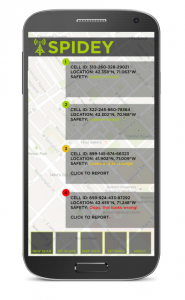Last week Kade and Nathan, from the ACLU and The Guardian Project respectively, gave a great talk about the problem we’re tackling: IMSI-catcher detection. Before their presentations I gave a presentation on the status of our project and got some great feedback. Based on the feedback and questions it’s apparent that we really figure out how to make sure people realize the problem that exists and why it might be important to them — how to really capture attention and get people to use our application long term.
Nathan went over our project at a very technical level: how cell towers work, how cellphones work, and why the problem is very challenging. He talked about E911 and how stolen phones can be blocked or turned off so they no longer work. These technologies and features are useful but make cellular phones relatively insecure even though they’re being relied upon more and more everyday.
Kade gave a great presentation on the legality of the issues and why this is actually a problem. She really answered the question of, “why should I care if I’m tracked, I don’t have anything to hide”. Kade went through several case studies such as the Ukrainian Government and NAACP v Patterson. She talked about the companies making Stringray devices (IMSI-catcher related products for law-enforcement use) and how law-enforcement agencies use this technology.
Our project is really starting to take shape and we’re working in parallel on the design and the technology for an Android application. While we’ve discussed many possible design candidates, we’ve really set down with one and are beginning to implement it. We are planning a work-party which will basically be a hackathon in which we can all get together and combine our knowledge to be more efficient. This will leverage the group knowledge on the problem at hand and allow everyone to work at full speed.

Mockup of the Spidey user interface for Android cell phones. Spidey shows the current cell towers discovered and their relative danger levels.
I presented several versions and mockups of the application during last week’s project update presentations. The above mockup shows the direction we’re heading and what we’ve currently been user testing with paper prototypes. User testing has allowed us to gauge the level of knowledge of people in our various user groups and figure out how people might interact with the application.